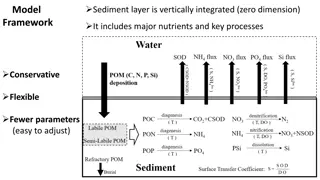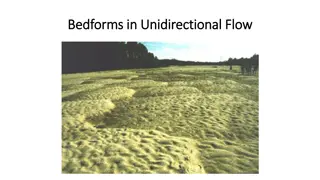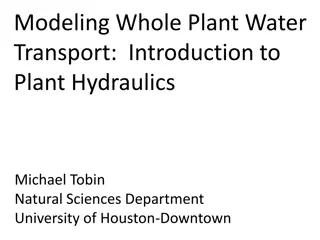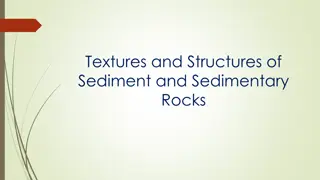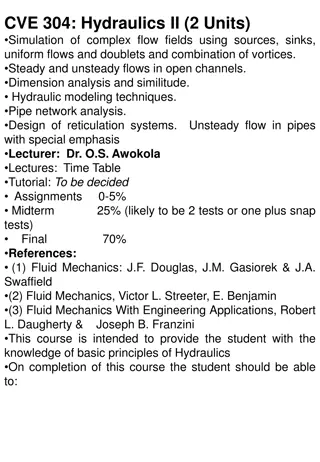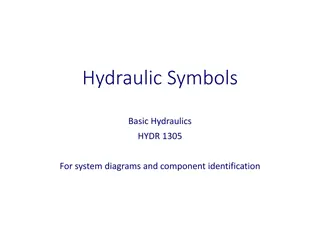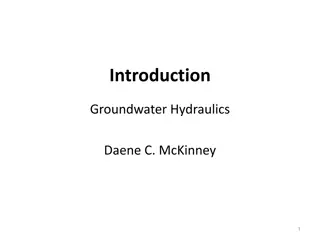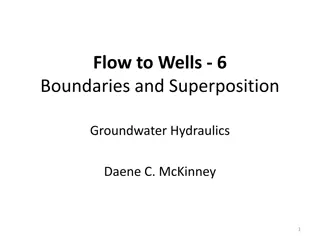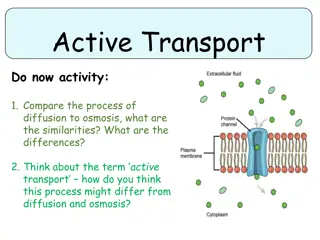Understanding Sediment Transport in Fluvial Hydraulics
Sediment transport equations play a crucial role in predicting sediment capacity under different flow conditions, aiding in various analyses like aggradation, degradation, scour, deposition, and migration. Different formulas cater to varied scenarios, distinguishing between bed load and suspended load, with some considering total sediment transport rates. The redefined concept of bed load transport involves particles gliding and rolling close to the bed, driven by critical shear stress. Theoretical considerations delve into forces affecting particle motion, emphasizing key parameters and dimensionless groups for analysis.
- Sediment Transport
- Fluvial Hydraulics
- Bed Load Transport
- Sediment Equations
- Theoretical Considerations
Download Presentation

Please find below an Image/Link to download the presentation.
The content on the website is provided AS IS for your information and personal use only. It may not be sold, licensed, or shared on other websites without obtaining consent from the author. Download presentation by click this link. If you encounter any issues during the download, it is possible that the publisher has removed the file from their server.
E N D
Presentation Transcript
Fluvial Hydraulics CH-6 Bed-Load Transport
Sediment Transport Equations Sediment transport equations used to determine CAPACITY for set of flow conditions Capacity needed for many different analyses such as aggradation/degradation, general scour/deposition, and lateral migration First step is to select appropriate equation: Predicated on an understanding of the system being studied Some formulas developed for sand-bed streams with high suspended load transport Other equations pertain to conditions where bed-load transport dominates Study objectives determine the portion of the sediment transport that needs to be estimated and the level of accuracy Some formulas independently predict bed load and suspended load Other formulas estimated bed-material load (i.e., bed load + suspended load) usually these equations do not include wash load Procedures exist that incorporate sediment sampling data, such as the modified Einstein procedure, that can estimate total sediment transport rate (including wash load)
Bed Load Transport Redefined Transport of sediments where the solid particles glide, roll or briefly jump but stay close to the bed Erosion of the bed (bed load transport) commences upon exceedance of the critical shear stress, o,cr Exists a number of formulas for predicting bed-load transport: Many are empirical but have incorporated dimensionless parameters More common equations for bed-load transport include: Duboys-Type Equations (Kalinske) Schoklitsch-Type Equations Meyer-Peter et al. (1948) sometimes called Meyer-Peter Muller (MPM) Einstein s Bed Load Equation
Theoretical Considerations Consider mobile bed of uniform and noncohesive particles Forces which lead to uniform and steady motion of a particle Hydrodynamic Force: u d 2 ( g 2 * FH f d u * ) Submerged Weight of Particle: 3 W d p s 7 Parameters: Fluid (density, viscosity), Solid (density, diameter), Flow (Depth or Hydraulic Radius, Slope and Gravity Friction Velocity)
Theoretical Considerations 7 parameters can be combined into 4 dimensionless groups: d u = Re * * 3 / 1 g ( ) = 1 d d s 2 * R S s 2 u h f = = = * o ( ) ( ) ( ) * or d d d s s s u = = = o * Fr ( ) ( R ) * * D 1 s gd d s s h = Relative Depth h or d d = = Relative Density s s s
Theoretical Considerations Transport of sediment can be expressed as a function of these 4 dimensionless variables: R d f = , , , h s d * * 2 q L = = = sb 1 q ( ) * sb T 3 s gd s q q = = sb sb u d Ud *
Theoretical Considerations Since the terms Rh/d and s/ are included in * and with *= f(Re*): ( ) ( ) = = f f * q ) d = sb 1 o f ( ( ) 3 s gd s s Expression links solid transport, qsb, to shear stress Increase in shear stress past critical is responsible for an increase in qsb
Theoretical Considerations We often assume the relation below can be expressed in terms of a power law: ( ) * = U 8 f = / o 2 U * o ( ) U b = = 2 q a b s sb s s
Bed-Load Transport Equations Be Careful!!! Formulas give reasonably satisfying results with the parameter domain for which they were derived Application of formulas should be done with great care!
Bed-Load Transport Equations duBoys-Type Equations: DuBoys (1879) proposed model for bed-load transport assuming that sediment moves in layers, each of which has a thickness 1stlayer is where tractive force balances resistance force between layers: ( ) = = DS c n o f f s
Bed-Load Transport Equations duBoys-Type Equations: If layer between 1stand nth moves according to a linear distribution, then n is the thickness of sediment material moving Thickness moves with an average velocity of vs(n-1)/2 3 m ) 1 ( n n s = = q v sb s 2 m
Bed-Load Transport Equations duBoys-Type Equations: Critical condition at which sediment motion is about to begin (n = 1) ( ) ( ) ( )cr o o n = v ( ) o = c = s q ( ) 2 sb o o o f s cr 2 cr o cr v = = characteri stic sediment coefficien t s ( ) 2 2 o cr
Bed-Load Transport Equations duBoys-Type Equations: Assumptions of this equation have been shown to disagree totally with observations of bed-load transport Bed load does not move as sliding layers (Schoklitsch, 1914) However, there is generally good agreement between this equation and field/laboratory data Proper use of the equation depends on correct evaluation of the characteristic sediment coefficient, Sidenote: generally all bed load equations based on excess shear stress are classified as duBoys-type equations
Bed-Load Transport Equations duBoys-Type Equations: Experiments of Schoklitsch (1914) proved duBoys model of sliding layers to be wrong, but did show that the equation fit the data well Uniform grains of various kinds of sand (limited data) and experimental flume experiment (small dimensions): 1 54 . 0 s = ( ) metric
Bed-Load Transport Equations duBoys-Type Equations: Straub (1935) - based on work of several researchers determined average values of several sand sizes Criticized because all data obtained from small flumes over a small range of particle sizes 173 . 0 4 / 3 English d = ( )
Bed-Load Transport Equations duBoys-Type Equations: Zeller (1963) gives graph for metric units:
Bed-Load Transport Equations duBoys-Type Equations: Shields (1936) proposed critical shear stress relation Intent was to present an abbreviated form of the factors influencing bed load transport Developed a semi- empirical tractive-force equation based on 1.06<ss<4.25 and 1.56<d<2.47 mm ( ) q = o o 10 sb s cr ( ) qS d e s
Bed-Load Transport Equations duBoys-Type Equations: Kalinske (1947) emphasized turbulence mechanism in flow above the bed: = f d u * ( ) o q sb cr o
Example Graf 6.D An artificial channel has been constructed to divert a certain discharge from a river. This channel has an approximately rectangular cross- section with a width of B = 46.5 m and a bed slope of Sf=6.5 x 10-4. Uniform flow is established when the flow depth is 5.6 m. Velocity-profile measurements suggest an average velocity of 1.8 m/s and n = 0.0212 (due to bed roughness). Estimate the bed-load transport using the Kalinske equation. Express the solid discharge as a concentration.
Example Graf 6.D Converting qsbto gsb: g = = = sb q Q q B G g B sb sb sb sb sb s Sediment concentration can be expressed in a number of different ways: Concentration by volume: Concentration by mass: Concentration by unit mass: 3 m Q s = = sb C s 3 m Q s kg G s = = sb C s kg G s kg G s = = sb C s 3 m Q s
Example Graf 6.D Relationship between these concentrations: = C C s s s C = = s s s C C ( ( ) ) s s + C s s m = + C m s s
Bed-Load Transport Equations Schoklitsch-Type Equations: Replaced excess shear stress criterion with critical water discharge (or depth): ( sb q q = ) q cr Gilbert (1914) expansive set of data for varying water discharge, energy grade line, and sediment properties 3 flumes of lengths 14, 31.5, and 150 ft Flume width ranged from 0.23 to 1.96 ft Discharge varied from 0.019 to 1.19 cfs Eight different kinds of sand (0.305 < d < 7.01 mm)
Bed-Load Transport Equations Schoklitsch-Type Equations: Schoklitsch first proposed equations in 1935 but modified them in 1950: Critical flow rate: 1 n / 1 2 = 3 / 5 cr q D S cr f d = = . 0 076 . 0 006 s D d m d d 40 cr S e = / 1 6 . 0 0525 n d 3 / 5 / 3 2 d = . 0 26 s q cr 7 / 6 S e
Bed-Load Transport Equations Schoklitsch-Type Equations: Schoklitsch first proposed equations in 1935 but modified them in 1950: Sediment discharge: 5 . 2 s ( ) / 3 e 2 = q S q q sb cr s : Establishe d for = 0 . 7 3 . 0 = d mm . 0 0004 . 0 020 S f
Example Graf 6.D An artificial channel has been constructed to divert a certain discharge from a river. This channel has an approximately rectangular cross- section with a width of B = 46.5 m and a bed slope of Sf=6.5 x 10-4. Uniform flow is established when the flow depth is 5.6 m. Velocity-profile measurements suggest an average velocity of 1.8 m/s and n = 0.0212 (due to bed roughness). Estimate the bed-load transport using the Schoklitsch equation. Express the solid discharge as a concentration.
Bed-Load Transport Equations 3 / 2 3 / 2 g g S = 4 . 0 17 sb e Meyer-Peter Muller (MPM): Switzerland research laboratory (ETH) Meyer- Peter et al. (1934): Laboratory flume with cross-section of 2 x 2 m and total length of 50 m (max discharge of 5 m3/s) and sediment discharge up to 4.3 kg/(s-m) Two grain sizes: 5.05 mm and 28.6 mm For sand, resulting bed- load equation d d = g q sb = sb s g q
Bed-Load Transport Equations Meyer-Peter Muller (MPM): ETH experiments were extended to include data with particle mixtures First attempt to include representative grain diameter with previous formulas failed Meyer-Peter et al. (1948) proposed following equation which fit all the data: ) ( ) ( s = ( 2/3 g R S sb = 1/3 hb M e 0.25 0.047 ( ) d d s s ( ) ) = s g q sb sb g sb q ( ) sb s
Bed-Load Transport Equations Meyer-Peter Muller (MPM): Meyer-Peter et al. (1948) : Rhb= hydraulic radius of bed Equivalent diameter = d50 Mis a roughness parameter: / 3 2 K ( ) = = 1 s no bedforms M M K s ( ) 1 bedforms M 21 d 1 . 26 = = = K grain roughness s / 1 6 / 1 6 d 50 90 U = = K total roughness s 3 / 2 / 1 e 2 R S hb Derived with d = 3.1-28.6 mm (applicable to d > 2.0 mm) Derived with Sf = 0.0004-0.020
Example Graf 6.D An artificial channel has been constructed to divert a certain discharge from a river. This channel has an approximately rectangular cross- section with a width of B = 46.5 m and a bed slope of Sf=6.5 x 10-4. Uniform flow is established when the flow depth is 5.6 m. Velocity-profile measurements suggest an average velocity of 1.8 m/s and n = 0.0212 (due to bed roughness). Estimate the bed-load transport using the Meyer-Peter et al. formulas. Express the solid discharge as a concentration.
Einsteins Bed-Load Transport Equation Developed in 1942 (empirical) and 1950 (analytical) Probabilistic model for transport of sediment as bed load Bed load transport is related to the fluctuations in velocity rather than the average velocity Beginning and end of motion are expressed in probabilistic terms with considerations for the lift and particle s weight Built on observations/experimental evidence: Bed load moves slowly downstream motion of an individual particle is quick step with long intermediate stops Average step made by any bed load particle is independent of flow condition, transport rate, and bed composition (always the same) Different transport rates due to changes in the average time between steps and the thickness of the moving layer
Einsteins Bed-Load Transport Equation Physical Model: Equilibrium condition of exchange of bed particles between the bed layer and the bed # particles deposited per time per unit bed area = # particles eroded per unit time per unit bed area Deposition: Each particle (d) has steps of length ALd and will be deposited over an area ALd long with unit width Let gs= bed load rate in weight per time per width, N/(m-s) Let is= fraction of bed load in given grain size Then gs is = rate at which given size moves through the unit width per unit time
Einsteins Bed-Load Transport Equation Physical Model: Weight of a single particle = sk2d3(k2= constant of grain volume) Number of particles of a certain fraction deposited per unit time and bed area: i g s s g i = s s )( ) ( 3 4 A d k d A k d 2 2 L s L s
Einsteins Bed-Load Transport Equation Physical Model: Erosion: Whether a particle will be eroded depends on the availability of the particle and on flow conditions (turbulence level) Let ib= fraction of bed material in a given grain size # particles of size d in a unit area of bed surface = ib/k1d2, where k1= constant of grain area Let pe/te= probablility of removal, where te= time consumed by each exchange # particles eroded per unit time and unit area: p i b d 1 e t 2 k e
Einsteins Bed-Load Transport Equation Physical Model: Erosion: No direct method is available for the determination of te Einstein (1942) suggests a function of vss: d t = k ( ) 3 e v g ss s
Einsteins Bed-Load Transport Equation Physical Model: Bed Load Equation (Equilibrium): Rate of deposition balances rate of erosion: ( ) g i i p g = s s b k e s 2 4 2 A k d k d 1 3 L s Exchange probability: pe= fraction of time during which the lift exceeds the weight of the particle at any one location Non-intensive sediment transport peis small and deposition is everywhere possible Strong sediment transport pebecomes larger and deposition is not everywhere possible
Einsteins Bed-Load Transport Equation Physical Model: Exchange probability: Einstein (1950) suggests that pecan be used to evaluate ALd : If peis small, distance traveled is constant: ALd = bd where bis approximately 100 For larger pe: Only (1-pe) particles can deposit after traveling bd And peparticles stay in motion would like to deposit but can t because after bd lift forces exceed weight Of these peparticles, pe(1-pe) are deposited after traveling 2 bd while pe2particles are still not deposited We can express the total travel distance as a series: d ( ) ( ) = n = + = n 1 1 b A d p p n d L b 1 p 0
Einsteins Bed-Load Transport Equation Physical Model: Substituting the series into the bed load equation: 1 p k k i g = 1 3 e s s ( ) 3 1 p k i gd 2 e b b s s 1 g = = Intensity of Bed Load Transport s ( ) 3 gd s s p i = = e s A A * * * 1 p i e b = Intensity of Bed Load Transport for individual an grain size *
Einsteins Bed-Load Transport Equation Empirical Relation (Einstein, 1942): p 42 42 = e A * * 1 p e 42 1 1 k k g 42 42 = 1 3 s A ( ) * * 3 k F gd 2 b s 1 s ( ) = . 0 816 F sand with d mm




